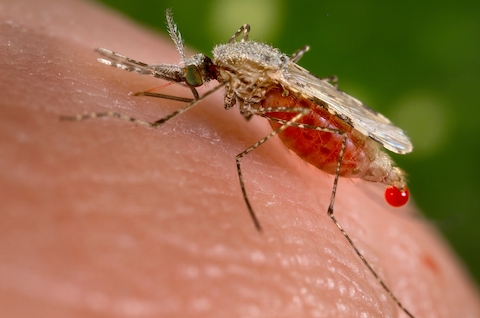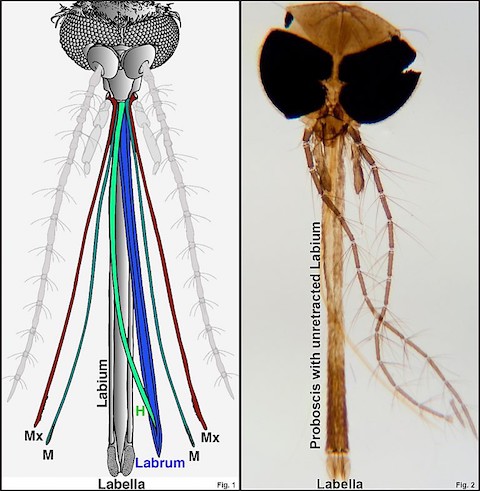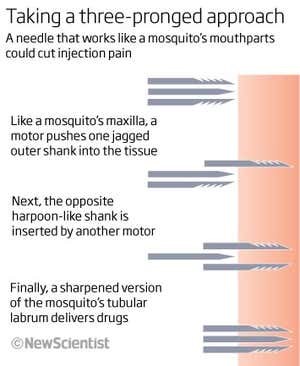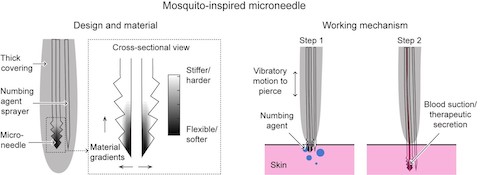
Credit: CDC Jim Gathany, public domain, via Wikimedia Commons
How would medical researchers build the perfect needle, for sensitive injections or brain-tissue sampling? Of course, they’d look to nature.
And where in nature would they find the perfect needle? On the sharp end of a mosquito!
Mosquitoes are the most dangerous creatures on Earth, carrying diseases that infect 700 million people a year and kill 2 million.
This is because, for millions of years, they’ve been so good at sticking their beaks into us.
They do this with a special six-part proboscis:
There’s a pair of maxillae, tiny serrated blades that vibrate to quickly saw into the tissue. A pair of mandibles holds the tissue apart as the maxillae cut, so they can continue deeper.
A tubelike hypopharynx injects saliva, which contains a numbing agent, an anticoagulant, and a blood-vessel dilator. And a V-shaped labrum draws up the blood.
Scientists analyzed these parts, then set out to copy them.
They built tiny saw blades of glass crystals and vibrated them with a piezo motor, like in a wristwatch. Two tiny needles held the puncture apart, while a third, ultrafine needle made the injection or drew the sample.
These are lubricated with a topical anesthetic and constructed to be flexible like a mosquito’s proboscis, which reduces the pressure at the puncture site by 30 percent.
The result is a completely painless microneedle for the most sensitive uses—a comforting gift from that most bothersome insect.
Background
Synopsis: The hypodermic needle hasn’t evolved much since the first successful injection by Francis Rynd in 1844, and despite improvements to hollow needles over time, the jab is usually painful. To avoid detection and death, the mosquito has evolved its jab over millions of years to the point that it is painless by developing a complex system of six “needles.” Scientists are using biomimicry to lessen the pain of injections by imitating the stealthy bite of the mosquito.
- Mosquitoes are sneaky, landing lightly, piercing a blood vessel, and stealing away with a blood meal before we can even feel them, leaving their characteristic itch behind.
- Mosquitoes find their victims by sensing carbon dioxide, perspiration, lactic acid, heat, and infrared light.
- Today, mosquitoes are Earth’s deadliest animal, transmitting disease to more than 700 million people each year and killing 1 million to 2 million.

Credit: Choo et al., Frontiers in Physiology
- Mosquitoes have been honing their vampire-like skills since the days of the dinosaurs.
- Upper Cretaceous amber from Canada captured a 79-million-year-old specimen, similar to today’s species, that would have buzzed around megaherbivores like Triceratops.
- Researchers believe mosquito “cousins” have been around for 226 million years, meaning they may have pestered pterodactyls in the Upper Triassic.
- These “flying syringes” had to evolve to use their complex mouthparts, or proboscis, to feed on blood without detection by their host, or they would have been swatted to oblivion.
- The mosquito proboscis contains a special appendage called the stylet made up of six special needlelike parts encased in a sheath with a soft tip.
- When the mosquito lands, the liplike tip (labella) makes direct contact with but stays outside the skin of the victim along with the protective sheath (labium), which buckles into a loop.
- The mosquito inserts all six parts of the internal stylet into the skin.
- Two of these parts are called maxillae (Mx, dark red), and they are like tiny steak knives that vibrate through the skin.
- Two are called mandibles (M, dark green), and they hold the puncture apart like forks so the maxillae can work.
- Another is the tonguelike hypopharynx (H, light green), which pumps saliva into the perforation to postpone immune response, prevent coagulation, and dilate blood vessels.
- The last is the labrum (blue), a gutter-shaped part with receptors that enable it to follow the scent of blood. Once a vessel is pierced, the hypopharynx covers the top of the labrum gutter to make a convenient straw for the mosquito.
- The mosquito concentrates red blood cells in her abdomen, separating them from water that she expels from the end of her abdomen.
- After the mosquito departs, the saliva left behind triggers an immune response, flooding the site with histamines, causing the familiar itching and swelling.
- Mosquito saliva is also responsible for transmitting pathogens including viruses, bacteria, and parasites that cause deadly and incapacitating diseases like yellow fever and malaria.
- Injection pain is unpleasant for many people, but fear of needles, trypanophobia, is a reality for about 10 percent of Americans, preventing them from getting blood tests or vaccines they may need, so researchers are working to develop a painless microneedle inspired by the mosquito’s stealthy bite.
- Smooth hypodermic needles contact a lot of surface area and pain-sensing nerves.
- Mosquito maxillae are serrated, so they touch the skin in fewer places, and less contact means less pain.
- Scanning electron microscopy shows us that while being inserted, the maxillae vibrate at about 15 hertz, slowing to 5 hertz once inside the skin.
- The serration and vibration are two of the keys to the mosquito’s painless bite.

- The first version of the tiny needle, developed in Japan, is just 1 mm long and 0.1 mm in diameter, with three parts.
- First, a tiny piezoelectric crystal motor shoots a miniscule, vibrating, serrated harpoon into the skin, followed by a second jagged barb. These tiny barbs are etched from silicon dioxide.
- Then a smooth microneedle pierces the skin between the two harpoons to deliver medicine or vaccines, or to extract samples.
- Although these needles eliminated sharp injection pain, they left a dull pain at the injection site, so researchers continued their development.
- Researchers studying the biometrics of mosquito bites added two additional critical elements required for a painless puncture.
- The first was pretty obvious—the numbing action of the mosquito’s saliva injected by the mosquito’s tonguelike hypopharynx.
- The second took a bit more investigation. The proboscis of female mosquitoes has variable stiffness, with more flexibility at the tip. The flexible tip is controlled by vibrational frequency and deforms the skin less, allowing the tip to pierce the skin with less force.
- The flexible tip, serrated needles, and rapid vibration reduce the force necessary to pierce skin by one-third compared to traditional hypodermic needles. Less force means less trauma and pain at the injection site.
- Armed with this additional knowledge, researchers at The Ohio State University figured out how to build a painless microneedle.
- Using the serrated vibrating needle design, two needles would be used for an injection.
- The first ultrafine tip would deliver a numbing agent, while the second flexible tip would deliver the injection or draw the blood.
- Neurosurgeons have used the same concepts to develop probes that imitate the mosquito’s stylet to sample brain tissue, decreasing risk of brain damage.

Credit: Bharat Bhushan, Ohio State University

